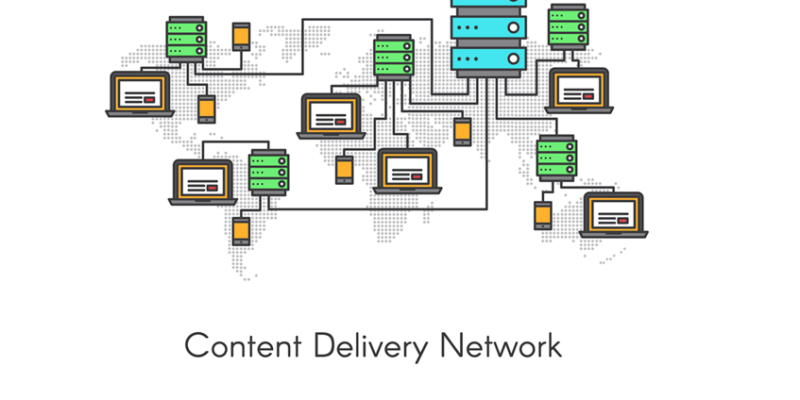
8 Best CDN Services for WordPress
A CDN service increases the speed of your website by serving cached static content like images, CSS and JavaScript files, from servers located near your user’s geographic location.
How this works is, when a user wants to go to a website that uses a CDN, the server closest to the user handles the request, ensuring the shortest distance in transmission of data and a noticeably faster site experience for all users. Before we get into the Best CDN services available for WordPress and how they stack up against each other, let’s try and understand why CDNs are so useful when it comes to speeding up your WordPress site.
Why do you need a CDN?
A site’s content needs to travel a shorter distance when it is stored in a server that is in proximity to the user (say the same city). This ensures a faster connection and quick loading. On the other hand, if the server is located far away (say a different continent), the website’s content has to travel a much longer distance, consequently resulting in a slower loading speed. It’s for this very reason that CDNs are so useful especially for website owners who have visitors from all over the world and experience high traffic.
In the absence of a CDN, your WordPress hosting company serves your website from a single location and all your website visitors access the same server. This leads to a slow download time and may also crash your server during peak traffic hours if you have not chosen a right hosting plan.
Now coming to the best choices of CDNs around, you’ve possibly heard of the vastly popular Cloudflare and maybe a few others like MaxCDN and KeyCDN. Choosing a CDN can be difficult though, because of each one having its distinctive features, pricing, and its pros and cons.
So let’s help you choose by taking a look at the top CDNs of 2017!
Content Delivery Networks
There are a few things you must keep in mind while choosing a CDN. These are your bandwidth requirements and where your visitors are primarily situated, how big your site is, and of course, how much you are willing to spend.
CloudFlare
In recent years, CloudFlare has managed to grow to a large extent, so much so that it is regarded as the ‘next generation’ CDN. It boasts of having a vast network of globally distributed servers, and it automatically caches static data. The company manages to make sure its users have access to highly advanced protocols on the web by emphasizing on delivering a Content Delivery Network that incorporates itself with latest emerging technology.
Typically, a site that uses Cloudflare loads almost two times faster, has 65% lesser requests and saves bandwidth by 60%. This is possible because CloudFlare caches your site’s static content and uses Anycast, a global network that allows the same IP address to be shared by various machines. When a request is sent to an Anycast IP address, the routers point it towards the closest machine on the network.
CloudFlare follows a flat-rate pricing approach, and it has turned out to be one of its most excellent features. Most other CDNs will charge you for additional bandwidth in case your site goes through a sudden increase in traffic. CloudFlare doesn’t do that, which implies predictable billing, thus eliminating any worry you might have about extra bandwidth charges.
Also, it is fairly easy to set up CloudFlare CDN in WordPress, and it has a user-friendly control panel to clean up cache and monitor performance. All this, along with the fact that it offers a free plan for smaller websites, makes CloudFlare one of the best CDN options available for WordPress. However, for the best performance, you can upgrade to the Pro plan ($20/month per domain) or the Business plan ($200/month).
MaxCDN
StackPath, a security-as-a-service startup, acquired MaxCDN last year. We’ll stick to the services provided my MaxCDN for our topic of discussion. MaxCDN is one of the most popular CDN options amid WordPress users and DevOps. The reason behind this is that its network is trustworthy has reached into 90 countries with a high peering capacity that can handle any given load across the globe.
MaxCDN uses MultiPath Network technology that facilitates intelligent best-path routing and on-the-fly analytics that help check packet loss and latency. Moreover, the CDN uses Anycast routing and custom FastStack technology powered by highly optimized NGINX caching on 100% SSD bare metal servers.
Now that may have been a lot of buzzwords for those of you not familiar with server terminology. So these are a few of MaxCDN’s user-friendly features: all-encompassing analytics, improved security, ability to manage your content’s behaviour on each edge server through the use of EdgeRules technology, and SSL options. The prices vary from $9/month for an Entrepreneur plan to $299/month for a Professional plan, and there is per-gigabyte pricing in case of custom plans.
Amazon CloudFront
Amazon CloudFront is a CDN service that Amazon itself uses to run its global network of websites. It securely delivers data, videos, applications and application program interfaces to your viewers with low latency and high transmission speeds. It succeeds in providing a highly scalable and reliable infrastructure to business and developers.
CloudFront has a global network of 98 edge locations that can be used by you to deliver your entire site content, including the dynamic parts of your site that vary for every user. Also, based on the URL path patterns on your website, it allows you to configure multiple origin servers and cache behaviours.
Some of CloudFront’s finest features include superior security, streaming features for audio and video, which are available live and on-demand, plus its reporting and analytics. With Amazon CloudFront, you pay according to what you use (just as other AWS services). If you are a new AWS customer, you get 50GB Data Transfer Out and 2,000,000 HTTP and HTTPS requests every month for a year.
Incapsula
Incapsula is yet another popular WordPress CDN solution. It is easy to set up and works well with WordPress caching and other plugins. Features offered by Incapsula include website application firewall, SSL, 24/7 support, and DDoS mitigation. But these are part of their paid CDN plans. The free version doesn’t include these features. The CDN has 40 strategically placed data centres around the world, which handle 11 million requests per minute.
As per Incapsula, it makes websites perform 50% faster while reducing bandwidth consumption by 40% to 70%. The CDN’s powerful dashboard allows you to get real-time information on your site’s traffic, performance, and security. You can also access detailed activity logs. The prices vary from $59/month per site for the Pro Plan to $299/month per site for the business plan.
KeyCDN
KeyCDN is another popular CDN option that’s easy to set up on many well-known platforms including WordPress. Although its reach isn’t quite as wide (especially since StackPath came along), KeyCDN offers easy pay-as-you-go plans, which can reduce pricing for smaller websites.
KeyCDN focuses on high performance and uses a tailored TCP stack, Anycast technology and geo-location routing. Also, user requests get routed to the closest POP available, while providing leading encryption standards & two-factor authentication, making the CDN very reliable and secure. KeyCDN uses 100% SSD for lower latency too, just as CloudFlare and MaxCDN. A powerful dashboard that provides for real-time reporting, analytics and information on the account usage are its other notable features.
CDN77
Of all the CDNs mentioned in this list, CDN77 is the newest. It launched merely five years ago in 2012 with just 3 data centres and now had 32 of them. The CDN aims at customer satisfaction through its reasonable and transparent pricing policy and an impressive array of features. These include speeding up of your website, software distribution, on-demand video/ live streaming, private CDN, and DDoS mitigation. CDN77 also provides specialized services for continuous gaming delivery, which distinguishes it from other CDNs in the market. Besides this, it enjoys the tag of being the first CDN that supported HTTP/2 and Brotli, in addition to Let’s Encrypt.
CDN77 allows a free trial as you get started. Then there is Pay-as-you-go pricing that starts at $0.049 for 1GB, with varying rates for different countries. There is no compulsion on monthly uses and no charges for HTTP/S requests. Moreover, you have an option of turning any PoP on or offering the network to handle your budget.
jsDelivr
An open source and free of cost CDN, jsDelivr can be used by any developer to host files, including plugins, font, CSS, and JavaScript. A feature that distinguishes jsDelivr from all other CDNs mentioned in this list is that it uses a one of a kind Multi-CDN system that is built on top of CDN networks offered by StackPath, Cloudflare, Fastly and Quantal. Also, custom servers are used in areas where there is very less or no presence of CDNs.
jsDelivr has a system that balances load. As a result, it ensures its users get the best possible uptime and performance. What happens when a file gets downloaded from jsDelivr by a user? The optimal provider for that user and specific time get found out from the performance. Also, from the available data for the last few minutes. However, this process gets completed in what is less than a few milliseconds.
IBM Cloud
IBM finally integrated the popular CDN, SoftLayer, into its Bluemix suite. A suite of cloud infrastructure services. Also, there is the partnership of IBM with Akamai, regarded as a “best of breed” CDN provider. As a result, it has led to the creation of one of the world’s fastest and most reliable CDNs. Moreover, it boasts of being the largest at 2,416 data centers.
IBM Cloud enables fast access and low latency of requested content around the globe. Also, it offers efficient delivery, flexible demand, usage and protection from security threats. Furthermore, these are features you would expect from a big CDN company, which get provided by it. Its servers come with a guaranteed small 2.0Ghz core. It gets allocated with 1:1 virtual-to-physical resources, and no over-subscriptions. Also, the prices are pay-as-you-go (making it cost-effective), and they start at $0.085 for the first 10TB.
Summary
Content Delivery Networks make it easier for anyone to access and load a site’s content faster. Hence, they solve the internet’s problem of geographical distance users and servers. So, were thinking of signing up to a CDN but not sure about which one suits you best even after reading the points above? Here is an attempt to solve your problem quick, based on the size of your website:
Almost all the options on this list will suit you if you run a small to medium sized website, i.e., around 40K to 50K page views. For enterprise level sites, Amazon CloudFront and IBM Cloud CDN will be a better option. Does your site offer a lot of streaming media such as audios, videos and gaming? The best options for you will be Amazon CloudFront or CDN77. Is the traffic on your site less or you are tight on budget? Well, you could check out the free plans of jsDelivr or CloudFlare.








